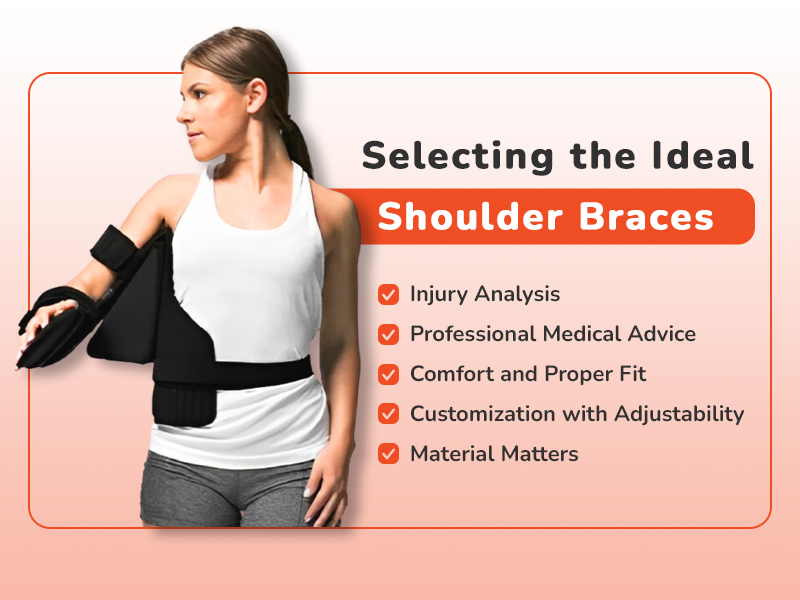Elevate Your Recovery: The Role of Shoulder Braces in Healing
Shoulder injuries, whether from sports, accidents, or repetitive strain, can significantly hinder your daily activities and quality of life. A shoulder brace is often recommended as a part of the recovery process. It supports the injured area, stabilizes the shoulder joint, and accelerates healing. This article delves into the role of shoulder braces in healing and offers guidance on selecting and using them effectively.
The Role of a Shoulder Brace
A shoulder brace serves a pivotal role in both recovery and pain management. It is specifically crafted to offer support and stability to the shoulder, a crucial yet vulnerable joint due to its wide range of motion. Whether it’s to recover from an acute injury such as a dislocation or sprain, manage chronic conditions like arthritis, or aid in the healing process post-surgery, a shoulder brace can be an indispensable tool.
How Shoulder Braces Aid Recovery?
Shoulder braces are engineered to restrict movement, preventing further injury and allowing the affected area to rest and heal. For individuals recovering from surgery, these braces ensure that the shoulder remains safe and immobile to facilitate proper healing. In cases of arthritis or other chronic conditions, they provide necessary support, reducing strain on the joint and alleviating pain.
Adaptability for Various Conditions
The versatility of shoulder braces lies in their ability to cater to a wide spectrum of shoulder-related issues. From sports injuries to post-operative care, the design and function of these braces are tailored to meet diverse needs. They are not just a physical support system but also a means to instil confidence in individuals as they navigate their recovery or manage ongoing conditions.
Exploring the Various Types of Shoulder Braces

1. Compression Shoulder Braces: Designed for Comfort and Mild Support
Compression braces, crafted from flexible, stretchy materials, are the go-to option for mild shoulder discomfort or minor injuries. They gently hug the shoulder, providing warmth and support without restricting movement significantly. This type of brace is perfect for those who need a slight boost in shoulder stability without compromising their range of motion.
2. Stabilizing Shoulder Braces: Robust Support for More Serious Injuries
Stabilizing braces come into play when dealing with moderate to severe shoulder injuries or in the post-surgical recovery phase. These braces offer higher support, ensuring that the shoulder joint remains secure and protected. They are typically more structured than compression braces and are instrumental in limiting movements that could aggravate the injury or impede healing.
3. Shoulder Sling Braces: Essential for Initial Injury and Post-Operative Care
Sling braces are a common sight following shoulder surgeries or significant injuries. Their primary function is immobilising the shoulder, keeping it elevated to reduce swelling and promote healing. Sling braces are crucial during the initial recovery phase when the shoulder must rest completely.
4. Hybrid Shoulder Braces: Combining Flexibility with Support
Hybrid braces strike a balance between flexibility and robust support. They typically combine compression and stabilizing braces, offering a versatile solution for those who require varying degrees of support throughout their recovery journey. These braces are useful for gradual rehabilitation, allowing for controlled movement as the shoulder heals.
5. Activity-Specific Shoulder Braces: Tailored for Athletic Needs
There are activity-specific shoulder braces for athletes or individuals engaged in specific activities. These braces are designed to consider different sports or activities’ particular motions and stresses. They provide the necessary support and protection while still allowing the range of motion needed for the sport, thus preventing injuries and facilitating a quicker return to activity post-injury.
Maximizing Recovery with Shoulder Braces: Key Advantages
1. Pain Management and Relief: Essential for Comfort
Shoulder braces play a crucial role in managing and alleviating pain. These braces significantly minimise discomfort by restricting unnecessary movements and providing stable support. This immobilization is particularly beneficial in acute injury phases or post-surgery, helping to create a pain-managed healing environment.
2. Reducing the Risk of Further Injury: A Protective Shield
One of the most significant benefits of wearing a shoulder brace is its protection. Keeping the shoulder area immobilized prevents the exacerbation of the existing injury. This is particularly crucial in tendonitis, dislocations, or fractures, where additional strain could lead to complications or prolonged recovery.
3. Enhancing Posture and Alignment: Guiding Correct Positioning
Consistent use of shoulder braces contributes to maintaining proper posture and alignment of the shoulder joint. This is vital not only for injury recovery but also for preventing future issues. A correctly aligned shoulder ensures balanced muscle use and minimizes the risk of repetitive strain injuries.
4. Accelerating the Healing Process: Aiding Faster Recovery
The supportive nature of shoulder braces aids in the healing process. By stabilizing the injured area, these braces reduce stress on the damaged tissues, allowing them to repair and recover more efficiently. This stability is essential in the initial immobilization phase and later stages of rehabilitation, where controlled movement is introduced.
5. Comfort and Support During Daily Activities: Functional Aid
Beyond injury recovery, shoulder braces offer comfort and support during daily activities, especially for those with chronic shoulder conditions like arthritis. They provide the necessary support to carry out routine tasks, reducing pain and improving the overall quality of life. This daily support can be a game-changer for individuals seeking to maintain an active lifestyle despite shoulder issues.
Selecting the Ideal Shoulder Brace: A Comprehensive Guide

1. Injury Analysis: Tailoring the Brace to Your Needs
Before selecting a shoulder brace, it’s crucial to understand the specifics of your injury. The nature and severity of the injury will influence the type of brace that is most suitable. For instance, more severe injuries might require a brace that offers greater immobilization compared to a brace for mild pain relief.
2. Professional Medical Advice: Ensuring the Right Choice
Consulting with healthcare professionals is a critical step in the selection process. They can provide valuable insights based on your medical history and specific condition, ensuring you choose a brace that aligns with your recovery needs and health objectives.
3. Comfort and Proper Fit: Essentials for Effective Use
A well-fitting brace is essential for both comfort and effectiveness. Ensure the brace fits snugly around your shoulder without impeding blood flow or causing discomfort. Remember, a brace that’s too tight can be counterproductive, while one that’s too loose won’t provide adequate support.
4. Customization with Adjustability: A Personalized Approach
Adjustable features are a significant benefit, allowing you to customize the brace for your unique body shape and support needs. This adjustability can be particularly important as you progress through different stages of healing and require varying levels of support.
5. Material Matters: Balancing Durability and Comfort
The material of the shoulder brace plays a pivotal role in overall comfort and durability. Look for breathable materials to ensure comfort during prolonged use and strong enough to withstand regular wear and tear. A quality material will ensure the brace maintains its shape and support over time.
Read More: Shoulder Pain Relief Made Easy with Shoulder Braces
Choosing the right shoulder brace involves a thoughtful balance of medical advice, personal comfort, and material quality. By considering these key factors, you can select a brace that not only aids in your recovery but also fits seamlessly into your daily life.
Effective Utilization of Shoulder Braces
1. Correct Application and Adjustment
Ensuring that the shoulder brace is worn correctly is fundamental to its effectiveness. Carefully follow the manufacturer’s instructions for wearing and adjusting the brace. It should fit snugly yet comfortably, providing support without restricting movement or circulation.
2. Integrating with Rehabilitation Regimens
A shoulder brace should be part of a holistic recovery approach. Combine its use with rehabilitation exercises as prescribed by a physical therapist. This integrated approach helps strengthen the shoulder muscles and accelerates the healing process.
3. Adherence to Usage Recommendations
Follow your healthcare provider’s guidance on the duration and frequency of wearing the brace. The recommended wearing schedule is crucial for proper healing. Overuse or underuse of the brace can affect the recovery timeline.
Maintenance and Care of Shoulder Braces
1. Routine Cleaning for Hygiene
Regular cleaning is essential to maintain hygiene, especially if the brace is worn frequently. Follow the specific cleaning instructions provided by the manufacturer to ensure the brace does not lose shape and effectiveness.
2. Inspection for Wear and Tear
Periodically check the brace for signs of wear or damage. A worn-out brace may not provide adequate support and could lead to re-injury.
Lifestyle Adjustments with Shoulder Braces
1. Modifying Daily Activities
Wearing a shoulder brace may require adjustments in performing daily tasks. Avoid moving your arm and shoulder to avoid actions that could exacerbate the injury.
2. Conscious Movement and Posture
Pay attention to your movements and maintain good posture to alleviate unnecessary strain on your shoulder. Being conscious of your posture and movements can significantly contribute to healing and prevent further injuries.
Effective use of a shoulder brace encompasses proper application, integration with physical therapy, adherence to usage guidelines, regular maintenance, and lifestyle adjustments. These practices ensure that the brace serves its intended purpose of supporting and expediting your shoulder’s recovery.
Conclusion
Shoulder braces are invaluable tools in the recovery from shoulder injuries. Understanding their types, benefits, and proper usage can significantly enhance your healing journey. Remember, while a shoulder brace is essential, it should be part of a comprehensive treatment plan that includes professional medical advice and physical therapy.



